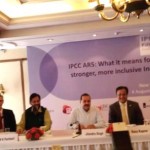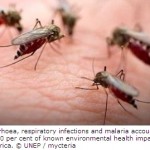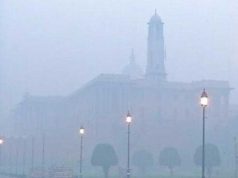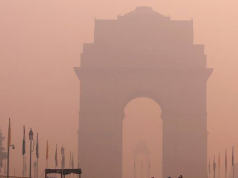 New Delhi – The Energy and Resources Institute (TERI) has released the findings of its Environmental Survey 2014, which was initiated to gauge the perception, awareness, opinion and behaviour of people towards environment in India. This year, the survey covered eight cities, including Delhi, Mumbai, Coimbatore, Guwahati, Indore, Jamshedpur, Kanpur and Pune. The focus of the survey was on the general environment, and in particular, water and waste related issues.
New Delhi – The Energy and Resources Institute (TERI) has released the findings of its Environmental Survey 2014, which was initiated to gauge the perception, awareness, opinion and behaviour of people towards environment in India. This year, the survey covered eight cities, including Delhi, Mumbai, Coimbatore, Guwahati, Indore, Jamshedpur, Kanpur and Pune. The focus of the survey was on the general environment, and in particular, water and waste related issues.
Overall, a large majority felt that air quality had worsened and the number of bird species in their cities had declined. However, a majority of people felt that drinking water availability and quality as well as waste management in their cities had improved. A vast majority of respondents (90 per cent) felt that climate change was a reality and a majority (over 80 per cent) out of those felt that average temperatures had risen and rainfall levels had gone down over time (over 63 per cent).

In his video message on the occasion, Dr. R. K. Pachauri, Director General, TERI, said, “This time, we have focused on cities which normally don’t get the kind of attention they deserve. If we want to bring about improvement in environmental quality, then the foundation on which any such effort would rest would be on the awareness of the public. I hope through this survey we are able to bring about the level of awareness that really lays the foundation for action in the right direction. If we don’t, then we would all be taken over by urban blight.”
Dr. Prodipto Ghosh, Distinguished Fellow, TERI, said, “TERI’s Environmental Survey 2014 of residents of eight major cities of the country provides usual insights into the attitude and perceptions regarding India’s environment. Urban respondents felt government and consumers played a positive role for improving the environment. The survey will be of immense value to policymakers in identifying areas where sound environment management policy can play a significant role, and where greater efforts of outreach and awareness building are necessary.”
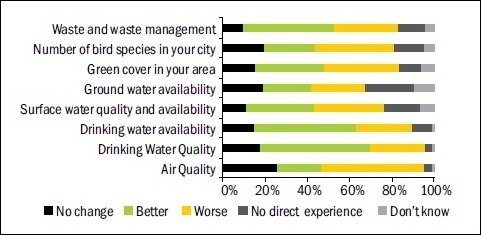
Environmental Indicators
The respondents showed a great deal of awareness and concern about the state of the environment. Over 90 per cent felt that the quality of the environment had an immediate impact on health. While close to 40 per cent felt that environment and development went hand-in-hand with no apparent trade-offs, a significant proportion (over 30 per cent) thought that the government should prioritize environment over development. It is worth noting that a higher proportion of women (48 per cent) as compared to men (36 per cent) felt that the objectives of environmental protection and development went hand-in-hand.
In terms of efforts to improve environment, over 40 per cent of the respondents ranked the government the highest followed by general consumers (by nearly 30 per cent). Nearly one-third of the respondents felt that academic/research organizations were putting in the least effort to address environmental concerns.
Water and Waste
On a positive note, a majority of people felt that drinking water availability and quality as well as waste management in their cities had improved. However, a slightly higher per cent of women (28 per cent and 30 per cent) felt that drinking water quality and availability respectively had deteriorated as compared to men (24 per cent and 24 per cent). The responses varied, though marginally, across localities for some of the indicators. Interestingly, the proportion of those who perceived an improvement in indicators like air quality, drinking water quality and availability, and tree/forest cover, was higher in high income localities when compared to other two localities.
Over 70 per cent of the respondents were aware of water being subsidized. Of those who were aware, over half felt that water should be charged as per usage and 35 per cent were against it. The majority (over 73 per cent) relied on municipal water supply though it is noteworthy that about 10 per cent of people relied on packaged water. Often, groundwater is used to supplement municipal sources of supply; hence, the reliance on groundwater in cities is likely to be much larger than indicated. Over 50 per cent of the respondents indicated that they were treating their drinking water before consumption though a significant 32 per cent didn’t do so. Larger percentage of respondents in high income localities (68 per cent) reported to be treating their water before drinking as compared to respondents from middle income (46 per cent) and low income (40 per cent).
On the issue of waste, close to 50 per cent of the people did not have garbage collected from their houses. This was higher for respondents from low income localities (56 per cent) than high and middle income localities (44 per cent and 45 per cent respectively). Once again, people showed a great deal of awareness about the issue. Close to 90 per cent felt that improper waste management imposed ‘severe’ (67 per cent) to moderate (23 per cent) health hazards. There seemed to be consensus on this among respondents across localities.
Generating less waste was seen as the best strategy to address the problem of waste management by around 60 per cent of respondents, followed by segregation of waste by 25 per cent. More than 50 per cent of respondents were not willing to segregate their waste into biodegradable and non-degradable.

